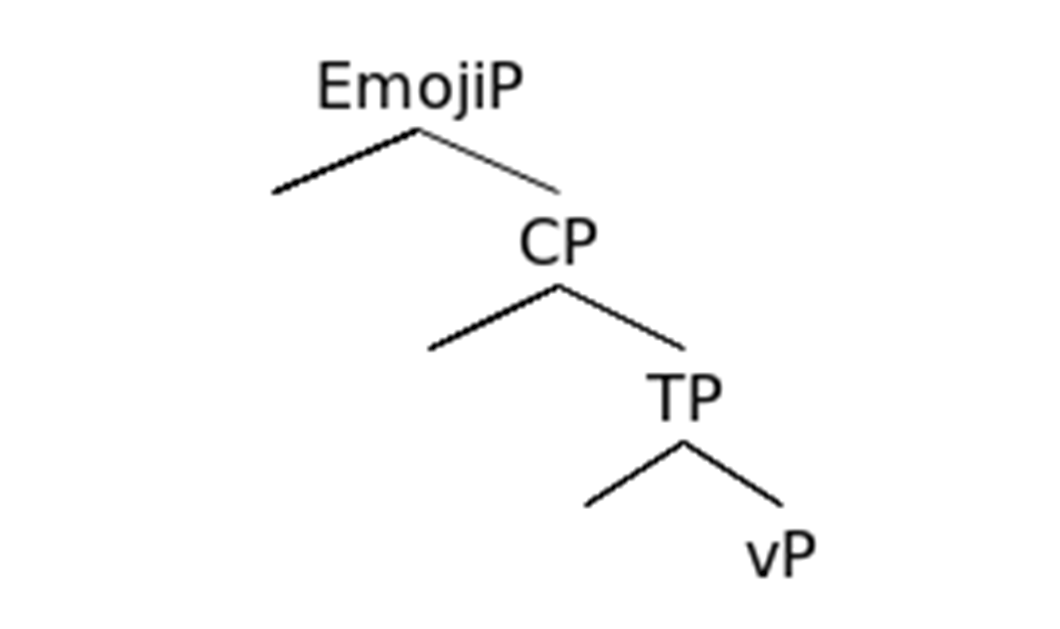This post was originally published on CamLangSci in May 2016. I repost it here (with some reformatting and slight modification) because CamLangSci seems to be down.
I love emojis. Who doesn’t? The lol face 😂 (official name: Face with Tears of Joy) was chosen by Oxford Dictionaries as Word of the Year in 2015, and the recently popular shrugging emoji 🤷 (according to Emojipedia) is just as expressive. Being called “words” seems to suggest that emojis are part of a verbal language (and indeed there have been linguistic studies of them), though one can’t really tell which language they belong to. English? Japanese? Or some “universal language”?
Well, it may be too early to grant a “language” status to emojis because, on the one hand, they can never be used as a first language (even if they had sounds), nor can human communication (this should be obvious, I’d hope) solely rely on emojis. On the other hand, these cute little ideograms can fit into any language, as you can see below.
(1) Emojis used in different languages:
a. 😋 Get list of all emojis to ✂️ and 📋. (English)
b. Les emojis de Samsung sont 🤢.
“The emojis of Samsung are ugly.” (French)
c. Muchos éxitos chicas 👏🎉!
“Many successes (i.e., good luck) girls!” (Spanish)
d. Guten 🌇! Montag ist doch ein schöner Tag 😴😷.
“Good morning! Monday is a good day.” (German)
Such ubiquity implies that if an emoji can play a role in one language, it would have a role to play in every language. In other words, emojis probably are universal, but they do not form a complete language; what they realize are probably some universally available linguistic concepts or categories.
Some of these categories are easier to translate back into verbal language, such as “copy” and “paste” in (1a) (Verb), “ugly” (French moches) in (1b) (Adjective), and “morning” (German Morgen) in (1d) (Noun). Others are less easy to translate. For example, the clapping-hands-plus-party-popper combo (or “compound emoji”) in (1c) intensifies the preceding proposition (a wish), and the sleeping-face-plus-face-with-medical-mask combo in (1d) depicts the mood of the speaker (presumably “sleepy and sick”). But these meanings are ineffable in the corresponding verbal languages Spanish and German—at least not with equal-sized elements (e.g., 1 emoji = 1 word). The face-savoring-delicious-food in (1a) is even more difficult to translate, for it is not even clear what its relationship with the English sentence is (perhaps it functions as a discourse marker like well).
If we want to incorporate these emojis into sentence structure, the translatable ones realize V, A, and N not so differently from their verbal counterparts. The “untranslatable” ones, on the other hand, probably realize some functional constituent adding discourse meanings to propositions. Following the tradition of syntax, let’s call this unknown constituent EmojiP (=Emoji Phrase).

Now, there are two interesting observations. First, this EmojiP may be sentence-initial (1a) or sentence-final (1c/d). Since the quasi-well in (1a) is not necessarily part of the following sentence, we can boldly assume for now that EmojiP is always sentence-final, regardless of the general head direction of the language—both French and German actually have head-initial CP, as illustrated in the emoji-free sentences below.
(2) Head-initial CPs in French and German:
a. J’ai dit [CP [C que] [TP j’aime les pommes.]]
“I said that I like apples.” (French)
b. Ich bin sicher, [CP [C dass] [TP ich meinen Reisepaß habe.]]
“I’m sure that I have my passport.” (German)
Second, the EmojiP elements, namely the emojis, do not necessarily depend on verbal sentences; they may well appear as standalone utterances and be assigned whatever interpretation our imagination renders. For example, someone texted their mom the emoji string in (3), which got two different interpretations.
(3) 🍴🌙🍝
Intended version: I had spaghetti for dinner last night.
Mom’s version: I had noodles and a croissant.
Such ambiguity is unlikely to arise in English (or any natural language), which can well distinguish last night (/læst naɪt/, Adverbial) and croissant (/krwɑːˈsɑ̃ː/, Noun) phonologically and categorially. Importantly, in English the time adverbial doesn’t come between the verb and its object, as in (4).
(4) *I had last night spaghetti.
In this sense, the mom’s understanding is more natural – she simply followed the VO word order of English. This said, the child’s choice of word order perhaps isn’t random either, because in the world of emojis the “preverbal” constituent is by default interpreted as the agent subject. So, without additional disambiguating mechanisms, neither (5a) nor (5b) could easily result in the intended interpretation.
(5) Emoji “word” order variation:
a. 🍴🍝🌙 (same problem as (3))
b. 🌙🍴🍝 (by default “some moon-shaped agent ate noodles”)
The above two observations have two implications for the syntax of emojis. First, EmojiP is an exceptional constituent which needn’t obey the head-initial phrase-structure parameter. In other words, it’s probably neither a head nor a specifier. Second, the emoji ideograms are only associated with minimal (and maybe unfixed) meanings but not syntactic categories. Therefore, their interpretation may change flexibly depending on where they are and what category the language user assigns to them.
Another interesting observation is that in languages with sentence-final particles, the function of such particles is quite similar to that of emojis, as in Mandarin Chinese.
(6) Emoji translations for Chinese sentence-final particles:
a. 祝你成功喔!
zhù nǐ chénggōng o!
“Wish you success 😊”
b. 週一不錯嗯⋯⋯
zhōuyī búcuò en…
“Monday is not bad 😔…”
Similar things seem to be happening in other languages too. In my own case, for example, I am often tempted to add either 😂 (lol) or 😝 (XD) at the end of English sentences, as in (7).
(7) Sentence-final emojis I often use:
a. That’s cool 😂
b. I dunno 😝
So, in languages without “official” sentence-final particles, emojis are potential candidates for the role, as least in the written informal register. And they are even more powerful than the real sentence-final particles, thanks to their rich visual effects and easily enlargeable inventory.



Leave a comment